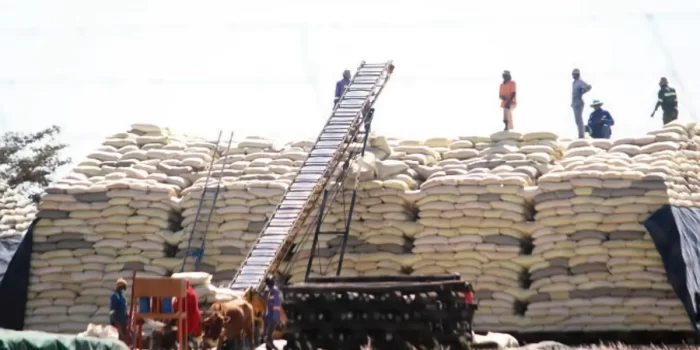A bumper harvest of maize and small grains, good rains, guaranteed food security and a projected agricultural sector growth rate of 34 percent — all combined to cheer the nation’s farming spirit in 2021.
The bumper harvest improved the country’s Gross Domestic Product growth, food security, national grain stock levels and significantly decreased Zimbabwe’s import bill, among other major scores for the economy. Government input schemes, timely inputs distribution, constant supply of key utilities such as power and fuel to farmers and crowding-in the private and financial services as enunciated in the Agriculture Recovery Plan all turned the fortunes of the sector for the good. It is also in 2020/21 that the agriculture industry, which had set a five-year growth target of US$8,2 billion, surpassed the mark in a single year, registering another milestone in the sector.
There were, however, some challenges, especially in some sectors such as cotton and tobacco where some farmers experienced problems on payments.
Maize production
After consecutive years of droughts and food insufficiency, 2021 saw farmers producing more than what is required for national consumption.
The good rainfall and Government support to farmers saw maize production increase by 199 percent from 907 628 tonnes produced in the 2019/2020 season to 2 717 171 tonnes.
The maize yield for the 2020/2021 season is the highest yield in 20 years because of the good rains and efficient farming programmes introduced by Government.
In addition to good rainfall, the practice of climate-proofed technologies (Pfumvudza/ Intwasa) significantly contributed to the increased yield levels supported by well-co-ordinated input programmes. Production of traditional grains increased by 128 percent from 152 515 tonnes in 2019/2020 to 347 968 tonnes for the 2020/2021 season. Sorghum increased to 244 063 tonnes, 135 percent more than 103 684 tonnes obtained during the 2019/2020 season.
Finger millet increased to 13 223 tonnes, 35 percent more than 9 799 tonnes produced in the 2019/2020 season.
Agriculture and the
US$8,2 billion industry
The Agriculture and Food Systems Strategy, a strong component of the National Development Strategy 1, envisioned the attainment of a US$8,2 billion agricultural industry by 2025, but this was achieved within a year in 2021.
The industry grew by a stellar 36,2 percent to US$8,19 billion in 2021 and is expected to grow by another 10 percent next year.
This record growth in agriculture is partially responsible for Zimbabwe’s record-breaking annual economic growth of 7,8 percent predicted for 2021, the highest in Africa in the year.
The Agriculture and Food Systems Strategy was launched in 2020 as an integral part of the national development agenda being driven by President Mnangagwa. The approach is anchored on enabling agriculture policy and the regulatory environment to facilitate the flow of investment into the sector; appropriate agriculture investments for productivity, food security and resilience; efficient agricultural knowledge, technology and innovation system; and the agriculture sector coordination for responsive planning, implementation monitoring and evaluation.
Wheat
Zimbabwe for the first time since 2005 became wheat self-sufficient as Government implemented the Agriculture Recovery Plan to boost food security and nutrition in line with Vision 2030 of attaining an upper middle income economy. Farmers this year harvested 337 212 tonnes of wheat from 66 436 hectares planted during the winter cropping season.
During the 2021 winter cropping season, 66 435.86 hectares were put under wheat, registering the third highest hectarage since independence and is only surpassed by plantings in 2004 (70 585ha) and 2005 (67 261ha).
Farmers close to water bodies to grow wheat including those with gardens, vleis and irrigation schemes were encouraged to grow wheat this year. Besides adequate water, farmers did not complain much about power outages as was the case during the past years.
Farmers in wheat growing areas were put in clusters for easy supply of power.
Cotton
Cotton farmers produced more than 150 000 tonnes of the crop during the 2020/21 season.
Cottco experienced challenges in paying the farmers and resorted to paying through groceries and household property such as furniture and farming implements.
Most farmers welcomed this move, with others calling on the parastatals to continue with the payments arrangement.
Cotton growers were, however, not happy with the delays in the payment of the outstanding dues from the previous season.
The farmers complained that this affected their operations. Government also intervened and paid farmers in batches.
Livestock
Beef cattle numbers increased from 5 443 770 cattle in 2019 to 5 478 648 2020 this season.
The major reasons for the increase in numbers included reduction in disease related deaths (especially Tick-borne diseases) and poverty deaths, improved breeding methods, improved pastures and feed due to early rains received.
The Department of Veterinary Services warned farmers against complacency in dipping cattle as this will result in an increase in tick-borne diseases cases and deaths.
The department said it had enough dip chemicals to last until the end of year and all farmers not taking their livestock for dipping will be prosecuted. With good rains projected for the 2021-2022 cropping season, economic prospects for Zimbabwe are set to even shine more on the background of the contributions by agriculture.
Source: The Herald

